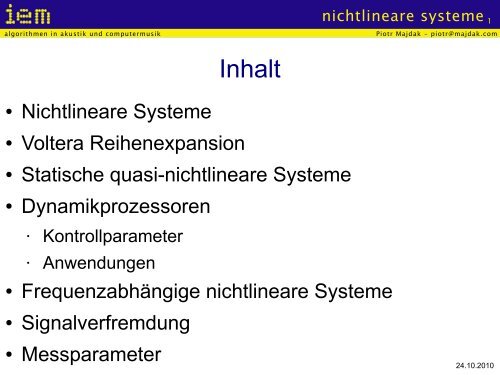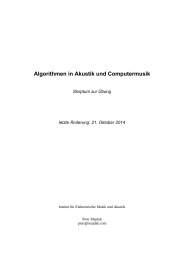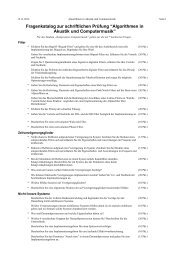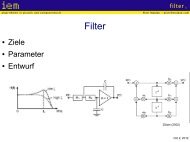N - Piotr Majdak
N - Piotr Majdak
N - Piotr Majdak
Erfolgreiche ePaper selbst erstellen
Machen Sie aus Ihren PDF Publikationen ein blätterbares Flipbook mit unserer einzigartigen Google optimierten e-Paper Software.
algorithmen in akustik und computermusiknichtlineare systeme<strong>Piotr</strong> <strong>Majdak</strong> - piotr@majdak.com1Inhalt●●●●●●Nichtlineare SystemeVoltera ReihenexpansionStatische quasi-nichtlineare SystemeDynamikprozessoren●●KontrollparameterAnwendungenFrequenzabhängige nichtlineare SystemeSignalverfremdung● Messparameter24.10.2010
algorithmen in akustik und computermusiknichtlineare systeme<strong>Piotr</strong> <strong>Majdak</strong> - piotr@majdak.com2Allgemein●LTI:AsinT BsinT H zZölzer (2002)●Nichtlinear TI:AsinT BsinT Zölzer (2002)∑nB n sinn⋅T n n∈N
algorithmen in akustik und computermusiknichtlineare systeme<strong>Piotr</strong> <strong>Majdak</strong> - piotr@majdak.com3Definition●Lineare Systeme:T {a⋅xtb⋅yt }=a⋅T {xt}b⋅T { yt}●Nichtlineare Systeme:●●●Systeme, die die obere Gleichung NICHT erfüllenKeine Einheitliche Definition für alle nichtlineare Systeme!Verschiedene Systemklassen: viele verschiedeneDefinitionen
algorithmen in akustik und computermusiknichtlineare systeme<strong>Piotr</strong> <strong>Majdak</strong> - piotr@majdak.com4Polynomiale Systeme●Klasse der polynomialen Systeme:py[n]=∑i=0f i { x[n], x[n−1] ,, x[n−N ] ,y[n−1], y[n−2] ,, y[n−M ] }● f i{ } ist ein Polynom der i-ter Ordnung●●Superposition verschiedener PolynomePolynomiales System des Grades p
algorithmen in akustik und computermusiknichtlineare systeme<strong>Piotr</strong> <strong>Majdak</strong> - piotr@majdak.com5Bilinearer Filter●Idee:x , y , x⋅y y[n]N 1y[n]=∑i=0N 2a ix[n−i]∑j=1N 3b jy[n− j ]∑i=0N∑4c ijx[n−i] y[n− j]j=0●●Rekursiver AnteilErweiterung eines linearen IIR-Filters
algorithmen in akustik und computermusiknichtlineare systeme<strong>Piotr</strong> <strong>Majdak</strong> - piotr@majdak.com6Quadratischer Filter●Idee:x , x 2 y[n]●●●System 2-ter OrdnungKeine RückkopplungErweiterung eines linearen FIR-Filters●●N 1y[n]=∑i=0h 1... Impulsantworth 2... KernfunktionN 2h 1x[n−i]∑i=0N∑2h 2[i , j]⋅x[n−i ]⋅x[n− j ]j=0
algorithmen in akustik und computermusiknichtlineare systeme<strong>Piotr</strong> <strong>Majdak</strong> - piotr@majdak.com7Homogene Gleichung●Polynomiales System:py[n]=∑i=0f i { x[n], x[n−1] ,, x[n−N ] ,y[n−1], y[n−2] ,, y[n−M ] }●●Übergang:Homogene Gleichung:y= f { x , y } y= f { h , x }f i { }=∑v 1∑v 2∑v Nh[v 1, v 2, ,v N ] x[n−v 1 ] x[n−v 2 ] x[n−v N ]Kernfunktion
algorithmen in akustik und computermusiknichtlineare systeme<strong>Piotr</strong> <strong>Majdak</strong> - piotr@majdak.com8●py[n]=∑i=1Volterra Series Expansionf i [n]=∑v 1 =0∑v 1 =0h 1 [v 1 ]x[n−v 1 ] ∑v 2 =0h 2 [v 1, v 2 ] x[n−v 1 ] x[n−v 2 ] ∑v 1 =0h p [v 1, v 2, ,v p ]∑ ∑v 2 =0 v px[n−v 1 ] x[n−v 2 ]x[n−v p ]Zölzer (2002)●Für leicht nichtlineare Systeme besonders gutgeeignet (Ordnung p ist klein)
algorithmen in akustik und computermusiknichtlineare systeme<strong>Piotr</strong> <strong>Majdak</strong> - piotr@majdak.com9Volterra System: Factored Kernels●Faktorisierung der Kernfunktionen:y[n]=∑v 1=0h i[v 1,v 2,,v i]=h i f [v 1]⋅h i f [v 2]⋅⋅h i f [v i]h 1 f [v 1] x[n−v 1] ∑ v 2 =0h 2 f [ v 2 ] x[n−v 2 ] 2 ∑ v N =0h N f [v N ] x[n−v N ] N Zölzer (2002)
algorithmen in akustik und computermusiknichtlineare systeme10<strong>Piotr</strong> <strong>Majdak</strong> - piotr@majdak.comStatische nichtlineare Systeme●Für Systeme ohne Speicher:●Kernh f i[v i] wird zu einem Skalar:h i [n 1, n 2, ,n i ]=A i ⋅[n]●Der Ausgang kann durch ein Polynom beschriebenwerden:y[n]=∑i=0A ix i [n]●Allgemein:y[n]= f x[n]
algorithmen in akustik und computermusiknichtlineare systeme11<strong>Piotr</strong> <strong>Majdak</strong> - piotr@majdak.comVerstärkungskennlinie●Für statische nichtlineare Systeme genügt eineKennlinie:y[n]= f x[n]y[n]x[n]Zölzer (2002)
algorithmen in akustik und computermusiknichtlineare systeme12<strong>Piotr</strong> <strong>Majdak</strong> - piotr@majdak.comDynamikprozessoren●●Veränderung der Einhüllenden laut ParametrierungHarmonische Verzerrung so gering wie nur möglichy[n]= f x[n]y[n]=x[n]⋅g [n]●in dB:Y [ N ]= X [ N ]G[ N ]Zölzer (2002)
algorithmen in akustik und computermusiknichtlineare systeme13<strong>Piotr</strong> <strong>Majdak</strong> - piotr@majdak.comVerstärkungskennlinie● Zusammenhang: Y[N] und X[N]Zölzer (2002)Zölzer (2002)
algorithmen in akustik und computermusiknichtlineare systeme14<strong>Piotr</strong> <strong>Majdak</strong> - piotr@majdak.comVerstärkungskennlinie - Parameter●Kompressionsfaktor:R= X Y●Steigung (Slope Factor):S=1− 1 RS =1− Y XR= 11−S Y { XZölzer (2002)
algorithmen in akustik und computermusiknichtlineare systeme15<strong>Piotr</strong> <strong>Majdak</strong> - piotr@majdak.comControl Parameter●Einhüllendenverfolgung (Envelope Follower):●●SpitzenwertEffektivwert (RMS)Zölzer (2002)
algorithmen in akustik und computermusiknichtlineare systeme16<strong>Piotr</strong> <strong>Majdak</strong> - piotr@majdak.comSpitzenwert● Attack time : AT =1−e −2.2T /t S ATt AT● Release time : RT =1−e −2.2T /t S RTt RTT S AbtastperiodeFTZölzer (2002)
algorithmen in akustik und computermusiknichtlineare systeme17<strong>Piotr</strong> <strong>Majdak</strong> - piotr@majdak.comEffektivwert (RMS)t AVR● Average time :TAV =1−e −2.2T S/t AVRT S Abtastperiode-●Andere Formen:●●CepstrumHilbert-TransformationZölzer (2002)
algorithmen in akustik und computermusiknichtlineare systeme18<strong>Piotr</strong> <strong>Majdak</strong> - piotr@majdak.comKontrollparameter●Dynamik der Kennlinie:●●Attack TimeRelease TimeZölzer (2002)
algorithmen in akustik und computermusiknichtlineare systeme19<strong>Piotr</strong> <strong>Majdak</strong> - piotr@majdak.comAttack Time●●●Attack TimeZu kurz:●●t ATDynamikfluktuationVerzerrungentieffrequenter SignaleZu lang:●Clipping-Gefahr● Bereich: 0 - 100msRane (1998)
algorithmen in akustik und computermusiknichtlineare systeme20<strong>Piotr</strong> <strong>Majdak</strong> - piotr@majdak.comRelease Time●Release Timet RTRane (1998)●●Zu schnell:●ChoppingZu langsam:●Atmen/Pumpen●Bereich: 100ms - 3s
algorithmen in akustik und computermusiknichtlineare systeme21<strong>Piotr</strong> <strong>Majdak</strong> - piotr@majdak.comAttack / Release Time Control● Struktur: f = f [n−1]− f [n]Richtung f , SchwelleUmschaltung zw.Attack und ReleaseKg [n]=K⋅f [n]g [n−1]⋅1−K Zölzer (2002)
algorithmen in akustik und computermusiknichtlineare systeme22<strong>Piotr</strong> <strong>Majdak</strong> - piotr@majdak.comDynamikprozessorenZölzer (2002)Zölzer (2002)
algorithmen in akustik und computermusiknichtlineare systeme23<strong>Piotr</strong> <strong>Majdak</strong> - piotr@majdak.comLimiter●●●Möglichst keine DynamikveränderungKontrolle der SpitzenwerteParameter:S L=1 R L=∞F =−S L⋅ X −LT ●Side chain:−S LZölzer (2002)Zölzer (2002)
algorithmen in akustik und computermusiknichtlineare systeme24<strong>Piotr</strong> <strong>Majdak</strong> - piotr@majdak.comLimiterThr=0.5t RT =5mst AT =100 usf s =44.1kHzZölzer (2002)Zölzer (2002)
algorithmen in akustik und computermusiknichtlineare systeme25<strong>Piotr</strong> <strong>Majdak</strong> - piotr@majdak.comKompressor / Expander●Parameter:0S C1 −∞S E0F C=−S C⋅ X −CT F E=−S E⋅ X −ET Zölzer (2002)Zölzer (2002)
algorithmen in akustik und computermusiknichtlineare systeme26<strong>Piotr</strong> <strong>Majdak</strong> - piotr@majdak.comKompressor / Expander●Hard vs. Soft Knee:●Alternative Struktur:Expander Linear Kompressor
algorithmen in akustik und computermusiknichtlineare systeme27<strong>Piotr</strong> <strong>Majdak</strong> - piotr@majdak.comNoise Gate●Parameter:●Hold timex[n]PEAKNTf[n]ATRTg[n]●Depth of Cut, Floor or Ratio ControlRane (2003)
algorithmen in akustik und computermusiknichtlineare systeme28<strong>Piotr</strong> <strong>Majdak</strong> - piotr@majdak.comDe-esser●●Reduktion der ZischgeräuscheUnterschied zum Kompressor: FrequenzabhängigeVerarbeitungZölzer (2002)
algorithmen in akustik und computermusiknichtlineare systeme29<strong>Piotr</strong> <strong>Majdak</strong> - piotr@majdak.comLet's rock●●●●Verzerren der Signale einer elektrischen GitarreUrsprünglich: RöhrenverstärkerJetzt: meist digital, mit simulierten KennlinienBeispiele:●●●OverdriveDistortionFuzz
algorithmen in akustik und computermusiknichtlineare systeme30<strong>Piotr</strong> <strong>Majdak</strong> - piotr@majdak.comOverdrive● Soft Symmetrical ClippingZölzer (2002)Zölzer (2002)
algorithmen in akustik und computermusiknichtlineare systeme31<strong>Piotr</strong> <strong>Majdak</strong> - piotr@majdak.comDistortion● Harte symmetrische ÜbersteuerungZölzer (2002)Zölzer (2002)
algorithmen in akustik und computermusiknichtlineare systeme32<strong>Piotr</strong> <strong>Majdak</strong> - piotr@majdak.comFuzz●●Asymmetrische KennlinieBeispiel (Tube Distortion):f x=x−Q Q−d x−Q1−e 1−e dQQ≠0, x≠Q Zölzer (2002)Q=−0.2d=8Zölzer (2002)
algorithmen in akustik und computermusiknichtlineare systeme33<strong>Piotr</strong> <strong>Majdak</strong> - piotr@majdak.com(Sub)-HarmonischeZölzer (2002)
algorithmen in akustik und computermusiknichtlineare systeme34<strong>Piotr</strong> <strong>Majdak</strong> - piotr@majdak.comExciter●●Betonung bestimmter Frequenzbereiche umKlangveränderungen hervorzurufenBeispiel: APHEX Aural ExciterZölzer (2002)Zölzer (2002)
algorithmen in akustik und computermusiknichtlineare systeme35<strong>Piotr</strong> <strong>Majdak</strong> - piotr@majdak.comKlirrfaktor k●●Total Harmonic Distortion (THD):k= ∑ n=2A n2A 1 2 ∑n=2A n2=Ak 2∑n=1A n2=1,2 ,Nk=k 2 2 k 3 2 k N2Total Harmonic Distortion + Noise (THD+N):THDN = E out −E inE outX out f = X in f ⋅H notch f ●Signal In Noise And Distortion (SINAD)●THD+Nin dB
algorithmen in akustik und computermusiknichtlineare systeme36<strong>Piotr</strong> <strong>Majdak</strong> - piotr@majdak.comTHD● Beispiel0 0.5 1 1.5 2 2.5 3 3.5 4 4.5 50-20-40-60Amp1_ch01amp0.0freq1000.0_adc0.wavsignalsearch for peak rangepeak foundmax of noisethreshold of peak energybins above thresholdamp in dB-80-100-120-140-160-180f in HzTHD=0.55296%x 10 4
algorithmen in akustik und computermusiknichtlineare systeme37<strong>Piotr</strong> <strong>Majdak</strong> - piotr@majdak.comWeiterführende Literatur●●●●W. J. Rugh. Nonlinear System Theory. The Johns HopkinsUniversity Press, Baltimore and London, 1981, ISBN: 0-8018-2549-0M. Schetzen. The Volterra and Wiener Theories ofNonlinear Systems. Robert Krieger Publishing 1980G.W. McNally. Dynamic range control of digital audiosignals. J. Audio Eng. Soc., 32 (5): 316 – 327, Mai 1984J. Challuper. Aural Exciter and Loudness Maximizer:What’s Psychoacoustic about “PsychoacousticProcessors?”. presented at the 109 th Convention of AES, Sept. 2000







